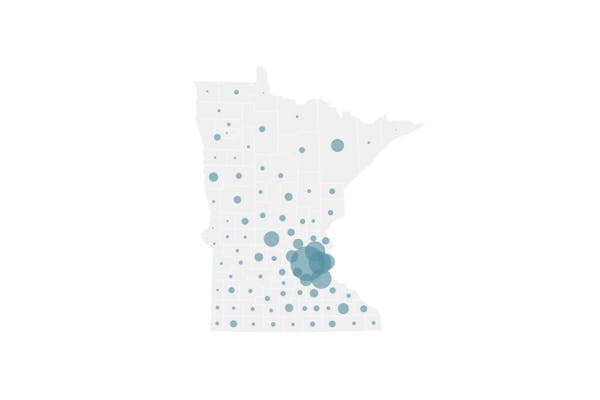Minnesota is reporting things ranging from ventilator tallies to total unemployment claims on a new online dashboard that state officials say will provide daily updates on the state's response to COVID-19, the global public health crisis that has claimed 22 lives statewide.
Gov. Tim Walz announced the data tool on Friday while saying that his stay-at-home order has been successful in slowing the spread of the COVID-19 virus in Minnesota. But, "the danger is still here," Walz said, as he urged residents to keep up the efforts.
The number of known COVID-19 cases increased by 47 on Friday, from 742 to 789, according to the Minnesota Department of Health, while the number of deaths increased by four. The state is trying to delay an expected surge of COVID-19 patients at hospitals, since the government and hospitals are still scrambling to find the supplies listed on the dashboard.
"A lot of folks are not putting out this information, because they are afraid it will create a sense of panic," Walz said in a 23-minute live video address on Friday afternoon. "You can see on here, we need more of these things. We need to continue to get them, we need them produced, we need the supply chain to work."
COVID-19 is a viral respiratory illness caused by a new coronavirus that surfaced late last year. Since the first case was reported in Minnesota on March 6, 156 people have been hospitalized. As of Friday, 86 people were in hospitals including 40 in intensive care units — counts that were up compared with Thursday.
Walz said he understands that for many Minnesotans, worry about the illness may be compounded by not knowing when the measures to slow the spread will end or understanding the plan behind them. To that end, he unveiled the new website, mn.gov/covid19, with a variety of data points ranging from the impact that "social distancing" rules have on freeway traffic to the supply of child care slots for critical workers.
In terms of hospital surge capacity, the dashboard shows Minnesota had 881 patients using ICU beds on Friday, plus another 264 available beds and the capacity to set up within three days another 1,623.
More than 800 of the state's 2,241 ventilators are in use, the dashboard shows, with 888 more machines on order. Ventilators can help patients with the most severe effects from COVID-19.
The state had a supply of 348,000 N95 masks that are critical pieces of personal protective equipment (PPE) for health care workers. It was unclear how the supply of masks, ventilators and ICU beds listed on the dashboard would handle a projected peak of COVID-19 patients or the rate at which hospitals typically use such items.
On unemployment claims, the dashboard showed Friday that the state's tally stood at more than 300,000 since March 16. That includes more than 22,000 claims on Thursday alone, said Steve Grove, commissioner of the state's Department of Employment and Economic Development, during a conference call with reporters.
It's been a week since Walz implemented the mandatory stay-at-home order requiring Minnesotans to remain in their homes for all but a few essential reasons, shuttering most businesses and closing schools likely for the remainder of the academic year.
"I want to be just very clear. I know these actions are painful," Walz said. "They're painful both social-isolation wise, and they are painful economically to many of you. The stress and disruption you're feeling is unprecedented."
Many with COVID-19 have mild or moderate illness, the Health Department says, and do not require a clinic visit. Most don't require hospitalization.
Public health officials have stressed that the reported case count understates the number in Minnesota who've been infected and sickened.
Minnesotans "want to see a light at the end of the tunnel — how are we going to know when it's time to be able to go back?" Walz told reporters, saying that new testing capabilities will help. "Those benchmarks of immunity, real-time testing, lessons learned and then mortality rates starting to drop will be things that we will look for."

'Safe recovery sites' would offer syringes, naloxone and more to people using drugs. The plan could be in peril.
New Minnesota GOP leaders seek peace with party's anti-establishment wing

Who is Republican Lisa Demuth, Minnesota's first House speaker of color?

